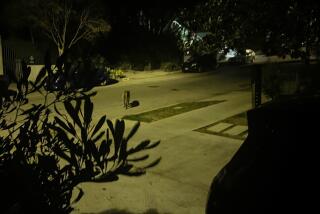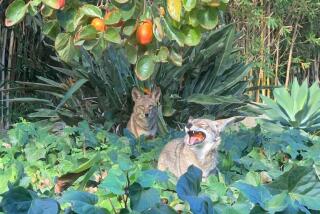Wally’s Walk on the Wild Side Ends : After 3 Years, Gator’s Caught
- Share via
Irvine resident Susan Pope was driving home at 12:40 Sunday morning when she saw the alligator on the sidewalk.
It was five feet long and ambling south along San Joaquin Road near the golf course.
Worried that someone might hit it, Pope called Irvine police. And--45 minutes, six police officers, one animal control officer and several netting attempts later--the thrashing, hissing reptile was captured and loaded into an animal control van.
So ended life in the wild for “Wally,” a spectacled caiman (a close relative of the alligator) who is believed to have patrolled the marshy waters of Upper Newport Bay and San Diego Creek for at least three years.
On Monday, the black and yellow-banded caiman was being held in a dog kennel at the City of Irvine Animal Services. Behind a door that warned “Do not open!! Alligator inside,” a beady-eyed, web-footed creature bared two rows of pointy teeth and hissed.
Asked if it was healthy, animal services officer Duncan Gill pointed to the reptile as it heaved its scaly chest and emitted one menacing s-s-s-s-s-s after another. “He sure looks healthy to me,” Gill said.
Although wildlife experts and animal control officers believe the creature in custody is Wally, they’re not absolutely sure. After all, said Irvine Police Sgt. Dick Bowman, “How do you tell one alligator from another?”
How, indeed? But on Monday, local wildlife officials who have held gator hunts in the Back Bay for the last three years were cheered.
“We have no indications there was more than one. . . . In time we’ll find out,” said Ron Hein, a wildlife manager for the state Fish and Game Department who was one of those looking for Wally.
Hein last week had called the caiman “secretive” and that it had apparently gone into hiding for three weeks. At the time, the caiman had not been spotted since the latter part of August, when biologists armed with nets, ropes and a possum carcass again failed to capture it.
Like several other local animal experts, Hein was glad that Wally appeared finally to be in custody.
“When we started out, it was reported as three feet long, and with each subsequent report it was getting bigger,” Hein said. “My concern was somebody was going to get hurt.”
Wally (who may actually be female; Irvine animal services officers said they don’t know enough about caimans to tell the difference) is believed to be a former pet whose owner tired of the fast-growing reptile and dumped him in Upper Newport Bay. (Caimans, South American reptiles that normally inhabit the sluggish waters of the Amazon, are not protected by U.S. wildlife laws and may be sold as exotic pets.)
The reptile is believed to have fed--and thrived, growing bigger than he probably would have in captivity--on a diet of fish, ducks, coots and sea gulls.
Animal services officer Dennis Ruvalo said he first heard of Wally three years ago, when an alligator was sighted in the bay, by the bridge at Jamboree Road. The caiman was seen off and on since then, most often since July, when an engineering crew dredging Upper Newport Bay drove it out of the bay and up San Diego Creek. His habitat disturbed, the caiman apparently continued east up San Diego Creek and into Irvine, possibly venturing onto the Rancho San Joaquin golf course with its several lakes, Ruvalo said.
Ruvalo, too, was glad the caiman had been captured. “The concern is for the safety of children. It would attack a child,” he said. Already the caiman had shown its aggressive nature; it had bitten a tire inside the Animal Services van and lunged at the bars when it was first caged, he said.
Even if Wally is an ornery critter, animal services officials vow they’ll find a suitable home for him.
Already, several reptile lovers, including an Anaheim man who reportedly keeps tanks of caimans in his backyard, have volunteered to take care of Wally, but state wildlife officials said they had not yet investigated any offers. Besides, biologist Hein said, wildlife officials would be looking for “an established zoo, an alligator farm, someone capable of rearing for it and caring for it,” rather than someone who wanted a backyard pet.
Meanwhile, Wally now stands bandylegged on the concrete floor of his cage at Irvine Animal Services. He is fed a ration of fish and his scales are hosed down daily, Ruvalo said. The caiman’s response is always a steady stream of hisses.
“We’re going to try and place him,” Ruvalo said as the hissing continued. “We’re contacting different zoos in the area. We’re going to keep him here until we find a suitable place.”
But whatever happens, Ruvalo said, “He will not go back into the wild.”
More to Read
Sign up for Essential California
The most important California stories and recommendations in your inbox every morning.
You may occasionally receive promotional content from the Los Angeles Times.













